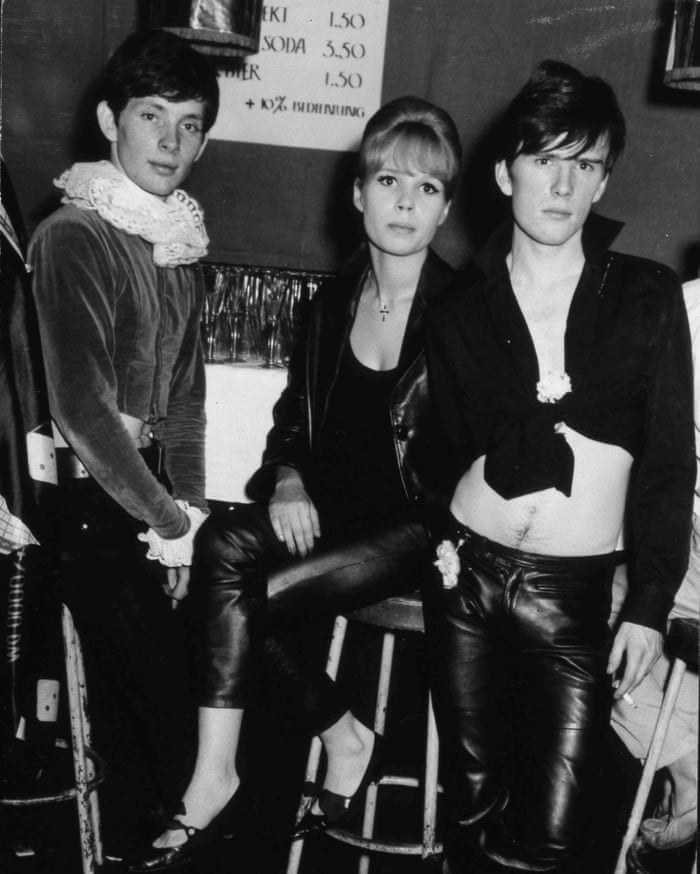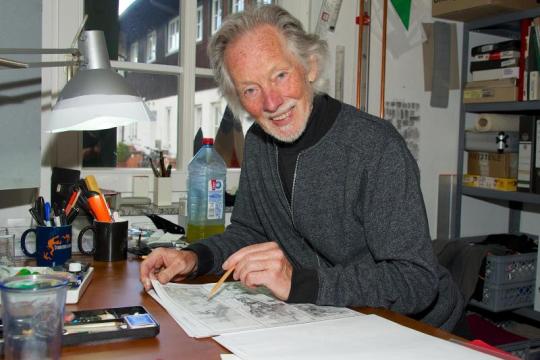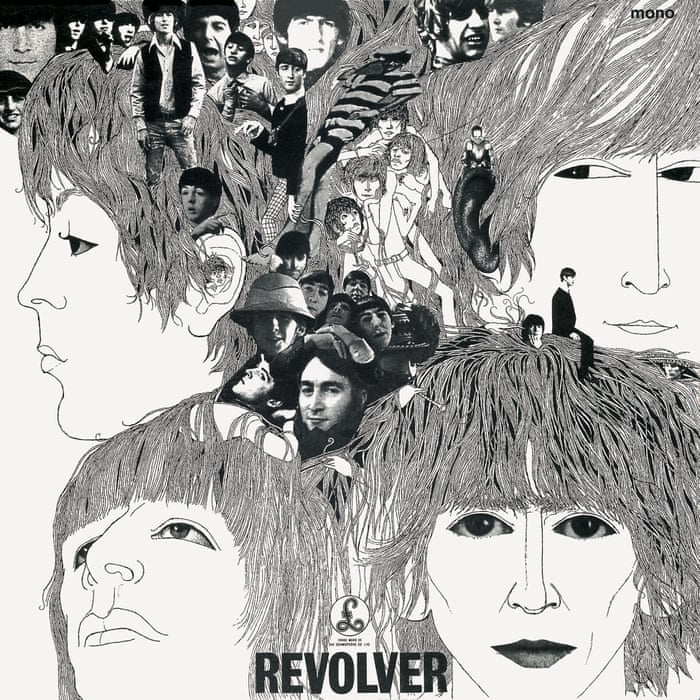How I drew a pop art masterpiece for the Beatles – a snip at just £50
Fifty years on, Klaus Voormann tells the story behind Revolver’s psychedelic cover
Robin Stummer
Sunday 24 July 2016

Klaus Voormann at his studio in Tutzing on Lake Starnberg, Germany, in June 2016. Photograph: Ursula Dueren/Alamy
Opening with a sharp swipe at Harold Wilson’s supertax rate for big earners, it ends half an hour later in a revolutionary mystical soundscape sculpted from LSD and dope, and drenched in technical wizardry the like of which had never been heard before. In between, a dozen of the finest pop songs ever written – including Eleanor Rigby, Good Day Sunshine and Here, There and Everywhere – all wrapped up in a piece of artwork as unexpected and intricate as the music it was created to contain.
Half a century after the release of Revolver, the Beatles album hailed not only as the group’s creative summit but arguably pop’s greatest achievement, the artist who designed the record’s monochrome sleeve – itself acclaimed as one of the finest pop artworks – has revealed how he did it: on a kitchen table in an attic flat, for £50.
Klaus Voormann – veteran Beatles confidant, inventor of the mop-top haircut, and member of the group’s inner circle of friends since their formative years playing Hamburg bars and strip joints – has decided to tell the story of his relationship with the Fab Four not in words, but in pictures. Voormann’s graphic novel, Birth of an Icon: Revolver 50, opens with his first encounter with the group one night in 1960 in a Hamburg bar, the Kaiserkeller, and traces their metamorphosis in five years from leather-clad rockers to multimillionaire psychedelic potentates, the greatest band in the world.

Klaus Voormann's new book:
Launch 05. August 2016
Revolver, the Beatles’ seventh album, was released in the UK on 5 August 1966. England had just won the World Cup and London was swinging. “Things stay in my memory because people keep on asking me about that time,” Voormann, now 78 and based in his native Germany, told the Observer. “I remember, where I created the Revolver cover. It was on the third floor of a house, in a little attic apartment, it was in the kitchen. Parliament Hill, Hampstead. I was staying there. I went back there recently, the building is exactly the same.”
A trained artist and musician, Voormann and his girlfriend, the photographer Astrid Kirchherr, were quintessential continental beatniks when they befriended the Beatles – sporting black clothes and a moody face beneath a low fringe. The look, especially the hair, heavily influenced the band’s early image. Voormann went on to spend much of the 60s and 70s alternating stints on the pop and rock circuit, playing bass with Manfred Mann, George Harrison and John Lennon – including on Lennon’s Imagine – with his work in graphic design and fine art.

Klaus Voormann, left, with Astrid Kirchherr and original Beatles bassist Stuart Sutcliffe at a party in Hamburg, Germany, circa 1961. Photograph: K & K Ulf Kruger OHG/Redferns
“1966 was the time when the Beatles were really, really busy,” Voormann recalls. “They were doing one album after another. They were just happy by then that they were spending more time in the studio, in the control room, messing around with sounds, than they ever did before. They had a German tour coming up, and also a Japan tour. They had just a few more weeks available to work on their new LP, the one which would be called Revolver, and then suddenly they were off on tour. I came to Abbey Road Studios to listen to the tracks for that album as they were recording them.”
The commission for the album cover design was unexpected, but, for the Beatles, characteristically spontaneous and left-field. “I got a phone call from John. He just said: ‘Got any ideas for our new album cover?’ I thought: ‘Shit! Doing a cover for the most famous band in the world!’ At moments like that you could suddenly forget that they had once been scruffy little Liverpool boys. I thought, ‘My God, I can’t do that!’”

As a freelance graphic designer in the early 60s, Voormann had created artworks for vintage jazz albums issued by Deutsche Grammophon. But to come up with ideas for a groundbreaking Beatles record, he needed to hear the new music.
“So the band all asked me to come down to Abbey Road Studios. This was when they had recorded about two-thirds of the tracks for that album. When I heard the music, I was just shocked, it was so great. So amazing. But it was frightening because the last song that they played to me was Tomorrow Never Knows.”

Sketch for the cover of Revolver.
The album’s climax, a sonic collage heavily influenced by hallucinogens and hash, and held together with a hypnotic drum pattern, baffled many fans and disorientated critics, but fed into the thinking for a design for the album’s cover. “Tomorrow Never Knows was so far away from the early Beatles stuff that even I myself thought, well, the normal kind of Beatles fan won’t want to buy this record,” says Voormann. “But they did.”
Voormann chose to work in pen and black ink, dotted with cut-out portions of photographs of the band members and forming a “waterfall” of imagery.

Klaus Voormann with the Revolver album
He says: “When I had finished my work for the cover, [Beatles manager] Brian Epstein was really moved by my design. He said to me: ‘Klaus, what you did is what we really needed. I was scared that the band’s new material wasn’t going to be accepted by their audience, but your cover built that bridge.’”
Voormann adds: “It took me about three weeks to create the cover, but in terms of concentrated work, about a week.” Much of that time was spent with scissors, scalpel and glue, selecting and arranging fragments of photographs within line drawings of the band members.

The cover of the Beatles’ seventh album, Revolver. Photograph: Alamy
“In choosing to work in black and white, I wanted not only to shock, but I wanted also for the work to stand out in a muddle of colour. But a psychedelic influence in the Revolver cover? Well, what is psychedelic? Look at Bruegel, or Hieronymus Bosch. Those guys were far out! I don’t know if they ate mushrooms, or whatever. But I know that whatever is inside of you doesn’t have to come out through drugs.”
Creating one of the most recognised and acclaimed covers for one of the greatest pop albums brought Voormann scant reward in the material world. “I got £50, or £40, for it. I would have done it for nothing – and I didn’t feel I was in a position to make it hard for them, by saying, ‘You have to pay me this or that much.’ They [EMI] said £50 is the absolute limit for a record sleeve. That’s what I got. Of course, I could have thought, ‘Well, Brian, if you think that cover is so good, come up [in money].’ Brian just left it to EMI, and EMI paid me £50, or £40.”
Following the success of Revolver and its cover – which won Voormann a Grammy award for artwork in 1966 – the Beatles looked to Peter Blake and Jann Haworth, leading figures of the British pop art movement, for their next cover, Sergeant Pepper’s Lonely Hearts Club Band, for which the couple were paid £200. Next, the group approached another British pop artist, Richard Hamilton, who came up with the white minimalist cover for the 1968 double album, The Beatles – each one an individual artwork thanks to its unique number embossed on the cover. But for many, Revolver stands out as not only the best Beatles cover, but also one of the great works of 20th-century graphic design.

“What was captured in the Revolver artwork was almost the first revolt against the San Francisco, west coast scene, whose look was all about super, hyper colour,” says Professor Lawrence Zeegen, dean of design at Ravensbourne College, London. “Voormann was brave … he kept things very stark. It fits the sound of the album – this very British version of what was happening with psychedelic music was important to capture visually.”
Copies of Birth of an Icon: Revolver 50 can be bought via www.voormann.com
voormann.com





»...it is good for me to see the other side of a story I know so well and to realize aspects like the sheer panic that Klaus must have felt at being asked to do our album cover. In the end, the REVOLVER cover was a classic and this book is another.«
SIR PAUL McCARTNEY
»...your REVOLVER book - it brought back such great memories - even farther back than REVOLVER... I hope it sells a million copies!...the REVOLVER cover was incredible and perfect for that album.«
RINGO STARR

fab4radio.blogspot.com

No hay comentarios:
Publicar un comentario